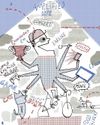The Pokémon Go craze may have faded, but it provides clues for retailers using technology to engage consumers.

In the summer of 2016, pedestrians on New York’s Fifth Avenue encountered crowds of (mostly young) people, hastily running into Central Park, smartphones in hand, shouting out Pokémon character names and cross-street locations. Within weeks of its release on July 6,2016, the Pokémon Go app attracted 40 million daily active users and created a level of in-app engagement that Facebook could only envy.
The Pokémon Go fad has faded, but it holds important lessons for companies intent on reaching and engaging consumers where they are, especially retailers: The game, the first truly social augmented reality (AR) experience, enthralled a new breed of omni connected consumers as nothing else had done previously. The people who embraced the augmented reality of Pokémon Go inhabit a world where the line between real and digital is so blurred that they essentially became one and the same — constantly augmented and improved by invisible technologies. And they are hungry for better, more personalized experiences.
This story is from the Summer 2017 edition of strategy+business.
Start your 7-day Magzter GOLD free trial to access thousands of curated premium stories, and 9,000+ magazines and newspapers.
Already a subscriber ? Sign In
This story is from the Summer 2017 edition of strategy+business.
Start your 7-day Magzter GOLD free trial to access thousands of curated premium stories, and 9,000+ magazines and newspapers.
Already a subscriber? Sign In

Transforming information into insight
Focus on six organizational elements to build a world-class data and insights capability.

THE URGENT NEED FOR SOPHISTICATED LEADERSHIP
The pandemic has highlighted a series of paradoxes inherent to the work of leaders. What comes next will depend on how well leaders face up to them.

The road to successful change is lined with trade-offs
Rather than trying to convince people your change initiative is the right one, invite them to talk openly about what it might take to implement it: the good, the bad, and the frustrating.

Sustaining productivity virtually
Maintaining productivity levels among remote employees is an enduring challenge. Here are five ways to help businesses and employees thrive while people work at home.

FORWARD TO normal
Entertainment and media companies are building business models that are resilient to the enduring changes in consumer behavior ushered in by COVID-19.

How leaders can promote racial justice in the workplace
Embrace four principles to turn today’s diversity, equity, and inclusion initiatives into sustained progress.

CREATING THE OFFICE OF THE FUTURE
In a remodeled world, it is vital for companies to reinvent ways of working.

Consumer companies must take leaps, not steps
As shoppers show how quickly they can adapt to external shocks, retailers will need to radically reconfigure their business models.

Businesses can fast-track innovation to help during a crisis
“Unrealistic” timelines can actually work. Here’s how.

Agility and experience management work better together
Many companies achieve early wins with separate transformational efforts, then stall. But if combined and enhanced using “return on experience,” or ROX, measures, these two programs can unlock each other’s potential.